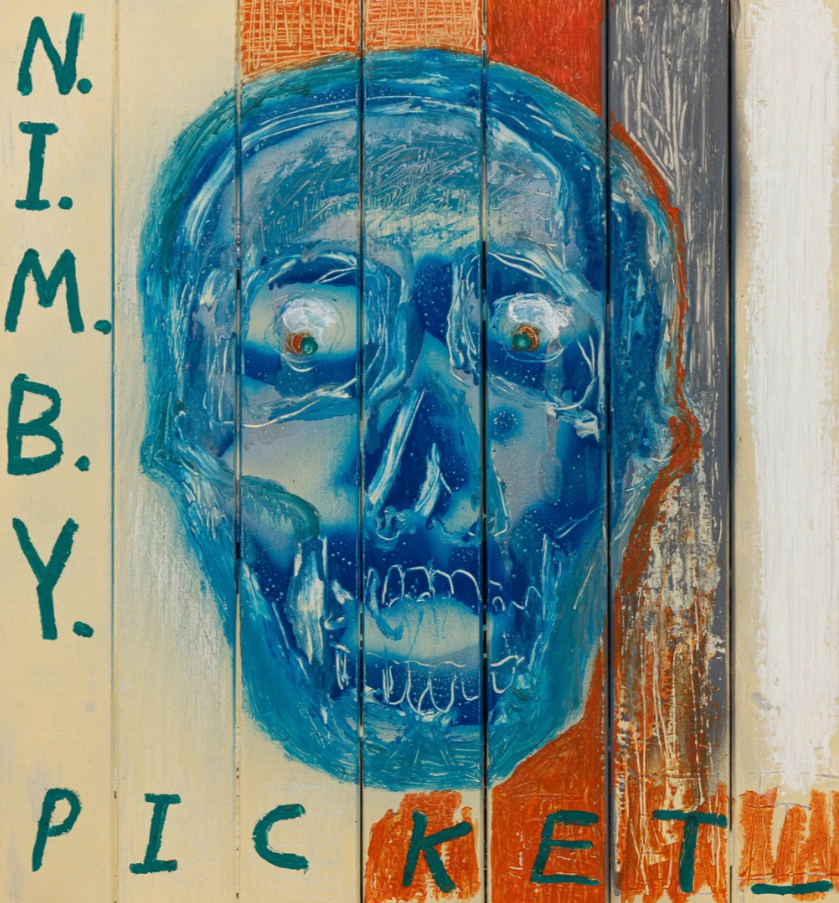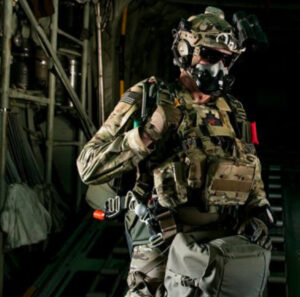Dirk Kruithof, an Australian contemporary artist with a distinct flair for the unconventional, has carved a unique niche within the international art community through his innovative use of recycled materials and bold artistic themes. His work reflects a nuanced understanding of the urban landscape, fusing vibrant colors with raw textures to create visual experiences that resonate with an edgy, streetwise sensibility. Known for his neo-expressionist style, Kruithof’s oeuvre traverses mediums and genres, blending painting, mixed media, and music into a cohesive expression of modern life’s complexities.
This essay delves into Kruithof’s artistic journey, focusing on his distinctive approach to painting, his thematic exploration of urbanity and identity, and the cultural significance of his work in the broader context of contemporary art. Particular attention will be paid to his painting “Nimby Picket”—a striking piece that encapsulates the artist’s ethos of using recycled materials and layered compositions to critique societal issues. Additionally, Kruithof’s interdisciplinary ventures, such as his musical projects, will be examined to provide a comprehensive view of his creative practice.
Neo-Expressionism Reimagined: An Aesthetic of Recycled Narratives
Kruithof’s art is heavily influenced by the neo-expressionist movement, which emerged in the late 20th century as a response to minimalism and conceptual art. Characterized by its emotive intensity, distorted figures, and vibrant use of color, neo-expressionism seeks to capture the chaotic essence of human experience. Kruithof’s interpretation of this style is particularly compelling because of his commitment to using recycled materials—a practice that not only aligns with his environmental consciousness but also adds a tangible layer of meaning to his works.
By incorporating discarded objects, spray paint, and other found materials into his paintings, Kruithof elevates what would otherwise be waste into powerful visual statements. This method can be seen as a form of visual alchemy, transforming the mundane and overlooked into art that confronts viewers with the realities of consumption, decay, and renewal. The textural richness of his surfaces, often rough and irregular, suggests a tactile engagement with the canvas that goes beyond traditional painting techniques. In many ways, this use of recycled elements situates Kruithof within the lineage of artists like Robert Rauschenberg and Jean-Michel Basquiat, who also used everyday objects and street aesthetics to disrupt the boundaries of fine art.
“Nimby Picket” is a prime example of this approach. The painting is an assemblage of vibrant hues, dynamic lines, and abstract shapes that converge in a layered, almost frenetic composition. The use of spray paint adds a gritty, urban quality to the piece, while the incorporation of non-traditional materials like metal scraps or cardboard lends it an industrial texture. This juxtaposition of bright colors and rough materials mirrors the tension between beauty and chaos inherent in urban environments. The title itself, “Nimby Picket,” references the acronym “NIMBY” (Not In My Backyard), which is often used to describe opposition to local development or change. This theme is subtly woven into the fabric of the painting, suggesting a critique of social and environmental hypocrisy—where people resist changes that inconvenience them while ignoring the broader impact of their own actions.
Themes of Urbanity and Identity: The Personal and Political Intersect
Kruithof’s paintings often grapple with themes of urbanity, identity, and the contradictions of modern life. His use of recycled materials can be seen as a commentary on the transient and disposable nature of contemporary society, where everything from objects to identities is in a constant state of flux. The urban edge present in his work is not merely an aesthetic choice; it is a thematic exploration of how cities shape and are shaped by the people who inhabit them.
In “Nimby Picket,” for instance, the fragmented forms and clashing colors evoke a sense of fragmentation and displacement. This visual dissonance can be interpreted as a metaphor for the fragmented nature of identity in a rapidly changing world. Urban spaces, with their mix of cultures, classes, and ideologies, serve as a microcosm for these broader social dynamics. Kruithof’s work captures this complexity, using abstract forms and vibrant palettes to reflect the diverse, often conflicting energies of city life.
Identity, in Kruithof’s art, is not a fixed entity but something that is constantly being negotiated and reconstructed. The recurring use of masks, distorted faces, and symbolic motifs in his paintings suggests that selfhood is as much a performance as it is an innate quality. This perspective aligns with postmodern theories of identity, which view the self as a product of cultural, social, and historical contexts. By foregrounding this instability, Kruithof’s work invites viewers to consider their own roles in the construction and deconstruction of identity.
Music and Art: A Multidisciplinary Dialogue
Kruithof’s engagement with music further enriches his artistic practice, providing another avenue for exploring themes of rhythm, improvisation, and emotional expression. His involvement in the band Rubber Necker, with whom he has released an LP, exemplifies his willingness to cross disciplinary boundaries and experiment with different forms of creativity. The synergy between his visual and musical endeavors is evident in the way he approaches painting—each brushstroke and spray of paint is imbued with a sense of rhythm and spontaneity that mirrors the improvisational nature of music.
This cross-pollination of music and visual art is not uncommon among contemporary artists, yet Kruithof’s approach is uniquely his own. His paintings often evoke a sense of movement and dynamism, as if the forms are pulsating to an unseen beat. The layering of colors and textures can be likened to musical layering, where different instruments and rhythms come together to form a cohesive yet multifaceted composition. This musicality lends his work an almost synesthetic quality, where the visual and auditory coalesce into a unified sensory experience.
Impression
In the broader context of contemporary art, Dirk Kruithof’s work stands as a testament to the power of interdisciplinary exploration and material innovation. His use of recycled materials not only makes a statement about environmental sustainability but also challenges traditional notions of what constitutes art. By elevating discarded objects to the level of fine art, Kruithof invites viewers to reconsider the value and potential of the everyday.
Moreover, his work’s neo-expressionist roots place him within a global dialogue about the role of emotion and gesture in art. At a time when digital technologies and conceptual frameworks often dominate the art world, Kruithof’s emphasis on physicality, texture, and direct engagement with materials offers a refreshing counterpoint. His paintings are visceral, inviting viewers to not only look but to feel—to engage with the work on an emotional and tactile level.
The incorporation of urban themes and critiques of modernity further positions Kruithof’s work within the tradition of socially engaged art. Like the street artists of New York in the 1980s or the environmental artists of the 21st century, he uses his practice to comment on societal issues, whether it be the contradictions of gentrification or the fleeting nature of identity in a hyper-consumerist world.
Dirk Kruithof is more than just a painter—he is a multidisciplinary artist whose work spans visual art, music, and social commentary. His neo-expressionist style, marked by the use of recycled materials and a distinctive urban aesthetic, challenges conventional boundaries and invites viewers to rethink their perceptions of art and society. “Nimby Picket” exemplifies his ability to weave complex themes into visually arresting compositions that are both deeply personal and politically resonant.
Through his art, Kruithof captures the essence of contemporary life—its contradictions, its beauty, its chaos—and transforms it into something extraordinary. His work is a reminder that art, at its best, is not just about representation but about transformation. By taking the discarded and making it new, Kruithof demonstrates that there is power and potential in everything, no matter how small or seemingly insignificant. In doing so, he cements his place as a vital voice in the ever-evolving landscape of contemporary art.
No comments yet.








